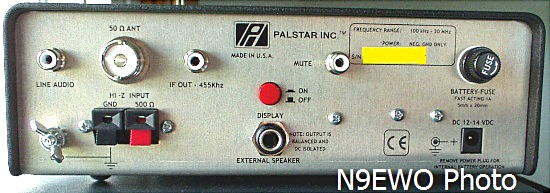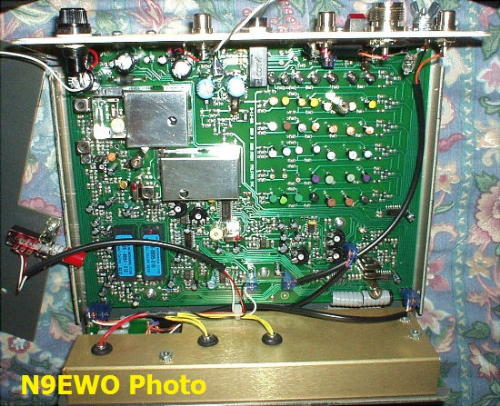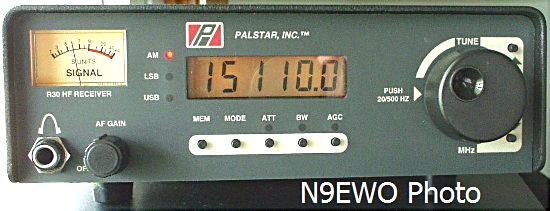N9EWO
Review :
Palstar R30 (CC)
HF Communications Receiver |
The discontinued Palstar R30 (CC) HF
Communications Receiver.
This
version featured Collins 5.8 and 2.5 kHz mechanical IF
filters.
Please Note : Later R30A version was not tested. (N9EWO Photo)
Discontinued
Receiver
Serial Number on Test Sample: R30 – 0196x
Antennas used in testing:
- Comet (Japan) H-422 dipole (34 ft long)
- RF Systems MLB "Long Wire" (55 ft long)
External accessory tested with the R30 : Sherwood SE3 MKIII Deluxe
Synchronous Detector (see text)
COUNTRY OF MANUFACTURE: USA
PRO :
- Excellent selectivity.
- Good dynamic range and front end filtering.
- Excellent “Mechanical” S-Meter.
- Lighted S-Meter and LCD display that also features an on-off switch.
- Fast - Slow AGC settings, and general AGC performance works well (see
con).
- 10 AA internal battery holder.
- Audio “line” output has good level.
- 455 kHz IF output jack.
- Well shielded microprocessor section.
- 100 memory channels store frequency, mode, attenuation, bandwidth and
even AGC setting.
- 3 different versions available with combinations of Murata ceramic
and/or Collins mechanical filters.
- Very useful tilt bail.
CON :
- Overpriced for what you get / Much better value with a used Icom
IC-R75.
- No direct entry keyboard, and no external accessory to add such.
- Broadcast band tuning is a chore, no 5 kHz “knob” step and 500 kHz
step slewing “up-down” makes band hopping a chore.
- Mechanical encoder used for tuning knob has poor feel and exhibits
excessive play while rotating.
- Intermittent microphonics noted on test sample when narrow filter, AM
mode, and internal speaker was used (see text).
-
S-meter lighting dimmed with AM signal and audio when driven to high
level (narrow bandwidth). LCD backlight uses incandescent bulbs (non A
version).
- No synchronous detector.
- Indifferent stability (drifts a bit until warmed up).
- Manual ECSS does not fair so well with 20 hz as the minimum step,
and poor tuning knob does not help to even tune this step.
- No AGC off or RF gain control.
- External speaker is marked as “Balanced & DC Isolated”, do not to
ground this output to cabinet (see text).
- Headphone jack only accepts mono phones, will require adapter for
stereo type.
- External Speaker jack is a weird quarter inch phone jack.
N9EWO Review :
PALSTAR R30CC Communications Receiver
(“CC” version tested which contained Collins 5.8 and 2.5 kHz mechanical
IF filters)
Out of the Box, Mono Headphone Jack
OK, we have a radio wrapped in bubble wrap, Styrofoam peanuts in the
box, (no solid Styrofoam on the radio ends) with a 12v wall wart power
supply and a simplistic 20 page operation manual that seems to explain
the sets operation just fine.
Couple of loose sheets include a “copy machine quality” spec sheet of
the set that also shows a block diagram of the R-30 on the rear side.
The other one goes over a procedure to align 4 MHz reference oscillator
crystal.
A small bag also in the box includes a ¼ inch phone plug (for external
speaker or headphone connection), Power plug and a MONO adapter plug
for the use with 1/8 inch plug headphones. We see a couple of fuses for
the rear socket also in the bag.
Note: The rear panel fuse is wired for use on the internal “10 AA”
batteries only, it uses an internal re-settable circuit breaker with
the external DC jack. 2 stick on feet to attach on the sets 2 hard
front
ones are also to be found.
One should keep in mind that the headphone jack is of a mono type, a
trip to the store for an adapter will be needed for use with stereo
headphones (a bit of a pity here).

Rear Panel of the Palstar R30 reeciver.
Don't ground the speaker output to the
chassis as it will damage the bridged IC amplifier ! (N9EWO Photo)
Solid Case Construction, good
shielding. Another “Stick On” front panel. Tilt bail useful.
The R30’s outer shell is robust and pleasant using treated aluminum
inside and out, top cover being painted with textured paint that looks
good. I did not see the use of any self-tapping screws anywhere. With
the main cabinet screws one should be cautioned not to loose the little
plastic washers as these can be lost very easily.
Palstar even used a shielded behind the entire microprocessor, which
can only help with RF performance.
Alas, the front panel uses the “stick on” method. That is the front
markings are printed on a sheet of vinyl and stuck to the front panel.
This is not really a downer as the Lowe HF-225, IDT WJ-8711A and
Ten Tec RX-340 all use the same method.
A nice tilt bail is found and is most welcomed. However, there is no
protection for it digging into a tabletop.
No keypad entry, Direct contact with
“Tact” Switches, Poor mechanical tuning encoder with sloppy feeling. 5
kHz “Knob” step badly needed.
A set without direct keyboard in this day and age is really
unacceptable. The R30 has none and no way to connect even an external
option like the Lowe HF-225 has.
The function buttons are a bit too small for my liking and are one is
actually placing your fingers right on the end of a tact button.
But the real problem with the controls deals with the tuning knob. It’s
a plastic knob with no weight, and to make to much worse a mechanical
type encoder that has so much slop and play in it to make it one of the
worst I have ever seen on a set. It seems to take forever even
with a
VRIT circuit in play to move a bit faster to get across a band using
the knob. The Icom IC-R75 uses an optical encoder on the tuning knob,
why not Palstar?
The “push it in” part of it for some functions is another nightmare and
I’m sure does not help the “loose” feeling of the encoder. It also
tends to slide around in use when one pushes this knob in (depends on
table surface), but perhaps the 2 stick on feet (stuck on the front 2
hard feet on the set) that are in the included little bag might be
useful here?
I would have liked to see a 5 kHz step for the tuning knob. It makes
for better band scanning across a SW broadcast band. We have to settle
for either a 20 or 100 hz step. A real "wrist wrecker".
Selectivity Excellent but maybe a rub
with the use of the mechanical filters? Meter light dimmed with audio
level.
Palstar felt that 3 versions were needed of the R30 for people that
love Collins mechanical filters. Our test version was the “CC” model
that has a 5.8 and 2.5 kHz Collins mechanical filters and splits
signals very well indeed.
On a number of occasions during testing (so it’s intermittent)
microphonics were noted when while using the narrow filter, AM mode,
and using the internal speaker. It howled like no ones business. This
was noted at a louder level mind you, but indeed there. Switching over
to the wider (5.8 kHz) filter, this disappeared totally. Also using an
external speaker cleared this problem up.
Not sure, but perhaps a connection with the use of mechanical filters
here ?
Another observation was with the lighting behind the S-meter. In any
mode, if I turn up the volume to a pretty loud level the S-meter light
dims with the audio level. I was thinking that the power supply was as
fault, but made no difference even when a 12 volt 1.5 amp regulated
supply was used. Even more weird is that the lights behind the LCD
appear not to be affected by this.
Use of 3 miniature light bulbs are used for the S-meter and LCD
lighting. These burn so dim that one should not have to worry about
replacement. Thank goodness too as these are hard wired (soldered) in
place and would not be an easy job for most to replace.

Internal view of the
Palstar R30CC receiver.
You can see the 2 incandescent lamps that are used to backlight the LCD
display. (N9EWO Photo)
AGC Excellent, Image and spurious
signal rejection appear to be good too. Sensitivity should be fine for
most applications.
We have an AGC fast-slow adjustment that works well. The entire AGC
circuit works well. Too bad that we have no “Off” and a RF-Gain control
to go with it.
Spurious and image signals appear to be “almost” totally absent. I was
able to find a few very low level (less than one s unit on the meter)
birdies at these frequencies: 4002, 6430, 10567.5, 14241.7, 17454,
21590, 29090, 29393 kHz. But again these are very low in strength and
most were covered up once an antenna was connected.
Sensitivity for the most part is OK too. For most people this will work
just fine. On really weak signals it did fall flat. Very weak signals
that were very hearable on my NRD-545 were not detected at all on the
R30. But at the price point the R30 is at was not a drawback to me. But
one is not going to break any DX contests with the R30.
But I have a feeling the Icom IC-R75 will show a stronger standing in
the real weak sensitivity area?
SSB reception works fine, not so well
for manual ECSS
LSB and USB amateur signals receive just fine on the R30. But when one
attempts manual ECSS (because “sigh” we have no Synchronous Detection),
it’s pretty disappointing. First the 20 hz fine steps are not quite
fine enough. And to make matters worse even tuning these fine steps is
almost impossible to fish out with the sloppy poor tuning knob. So it
leads to just giving up manual ECSS on this set.
100 Memory Channels that stores all
important info
100 memory channels that not only store frequency and mode , but also
attenuation setting, AGC and bandwidth. You are able to view these
channels either as CH and the number OR by the actual frequency. Well
thought out here I felt.
Audio Quality “Pinched”. Good level
“Line” output. “Balanced” External Speaker Jack.
When it comes to audio quality with the R30, well I don’t care for it.
The wide 5.8 kHz filter makes for “pinched” audio and appears muffled
when center tuning. Off tuning by a 1 kHz or 2 allowed for improved
listening without any real additional distortion. Not all sets can do
this, but you can get away with it well on the R30 at least in my
testing.
Phono jack on rear (where it should be) for audio “line” output has a
good level for tape recorder and external amplifiers alike.
Just as it was on a number of Drake sets in the past, the external
speaker jack is marked as “Balanced & DC Isolated”, perhaps a bit
of caution here not to ground this output to the cabinet !
When connected to “Sherwood SE-3
Synchronous Detector MKIII Deluxe”
The Sherwood SE-3 Synchronous Detector (also discontinued) connected to
the R30’s IF output jack certainly improves reception quality with
decreased distortion along with selectable sideband rejection.
The only fly in the pudding in our testing was that on certain weaker
signals (does not appear on all signals) I heard what I would call a
“buzzy” sound mixed in. Perhaps on a fade but not always either.
While not being on many signals and not severe even when it does
appear, this is still one really has to weigh with the excessive cost
of a used SE-3. (deluxe version) connected to a $ 500 to $ 700 receiver.
If one can find a used SE-3 for their Palstar R30 receiver, it will not
lead
to disappointment. It does help for better audio but at a steep price
at almost for what the R30 cost all by itself.
BOTTOM LINE : We do not care for it and would not own one.
The USA manufactured Palstar R30 is a worthy entry in the lower end of
the tabletop
market for that era, and performs decently for the most part (now
of course discontinued). Problem is lacking a keypad has a difficult
time to band
scan properly with broadcast stations or change
bands easily and makes for a bit of a nightmare for ease of use. The
poor
tuning knob (encoder) adds heavily to the problem. Also the Icom
IC-R75, which sold for about the same (or even a bit less
depending on
version), performs better in the weak sensitivity area and has more
features to boot. My choice would definitely be the
also discontinued Icom IC-R75 (our review here)
if I were making a choice between the two.
Dave N9EWO
© N9EWO, all rights reserved
Ver 2.0
Discontinued
Receiver
Palstar
R30 links for additional Information (all subject to change without
notice)
R30 eHAM Reviews
New
Zealand Radio DX Leauge - Palstar R30 Review
R30
PC Board Layout (PDF)
QST
Review of the Palstar R30 (November 2002, page 6)



